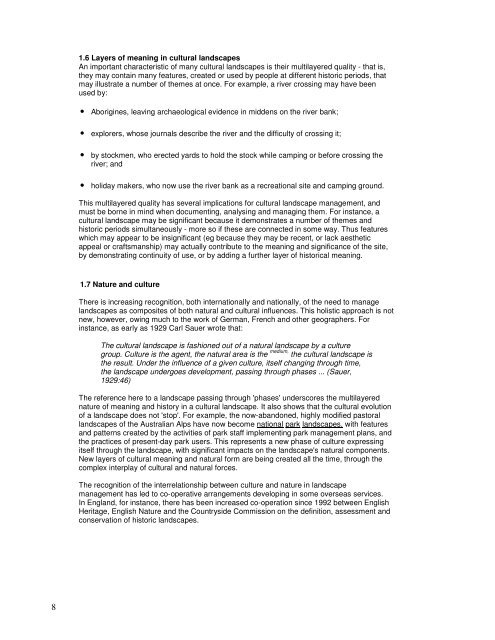Cultural Landscape Management - Australian Alps National Parks
Cultural Landscape Management - Australian Alps National Parks
Cultural Landscape Management - Australian Alps National Parks
You also want an ePaper? Increase the reach of your titles
YUMPU automatically turns print PDFs into web optimized ePapers that Google loves.
1.6 Layers of meaning in cultural landscapesAn important characteristic of many cultural landscapes is their multilayered quality - that is,they may contain many features, created or used by people at different historic periods, thatmay illustrate a number of themes at once. For example, a river crossing may have beenused by:• Aborigines, leaving archaeological evidence in middens on the river bank;• explorers, whose journals describe the river and the difficulty of crossing it;• by stockmen, who erected yards to hold the stock while camping or before crossing theriver; and• holiday makers, who now use the river bank as a recreational site and camping ground.This multilayered quality has several implications for cultural landscape management, andmust be borne in mind when documenting, analysing and managing them. For instance, acultural landscape may be significant because it demonstrates a number of themes andhistoric periods simultaneously - more so if these are connected in some way. Thus featureswhich may appear to be insignificant (eg because they may be recent, or lack aestheticappeal or craftsmanship) may actually contribute to the meaning and significance of the site,by demonstrating continuity of use, or by adding a further layer of historical meaning.1.7 Nature and cultureThere is increasing recognition, both internationally and nationally, of the need to managelandscapes as composites of both natural and cultural influences. This holistic approach is notnew, however, owing much to the work of German, French and other geographers. Forinstance, as early as 1929 Carl Sauer wrote that:The cultural landscape is fashioned out of a natural landscape by a culturegroup. Culture is the agent, the natural area is the medium, the cultural landscape isthe result. Under the influence of a given culture, itself changing through time,the landscape undergoes development, passing through phases ... (Sauer,1929:46)The reference here to a landscape passing through 'phases' underscores the multilayerednature of meaning and history in a cultural landscape. It also shows that the cultural evolutionof a landscape does not 'stop'. For example, the now-abandoned, highly modified pastorallandscapes of the <strong>Australian</strong> <strong>Alps</strong> have now become national park landscapes, with featuresand patterns created by the activities of park staff implementing park management plans, andthe practices of present-day park users. This represents a new phase of culture expressingitself through the landscape, with significant impacts on the landscape's natural components.New layers of cultural meaning and natural form are being created all the time, through thecomplex interplay of cultural and natural forces.The recognition of the interrelationship between culture and nature in landscapemanagement has led to co-operative arrangements developing in some overseas services.In England, for instance, there has been increased co-operation since 1992 between EnglishHeritage, English Nature and the Countryside Commission on the definition, assessment andconservation of historic landscapes.8
















